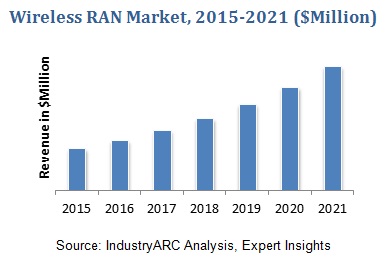Wireless Radio Access Network (RAN) is a part of mobile telecommunication system. It is wireless network infrastructure associated with macro cell RAN used for sharing cell sites, transport infrastructure, radio spectrum, and baseband processing resources. Radio and network as a service and baseband processing on the cloud are innovations to increase the data usage efficiency. It lays between devices such as mobile phone, computer and remotely controlled machine and provides connection with its core network. Wireless Ran provides connectivity between core network and the user equipment. It is a new wireless concept which provides flexibility, scalability and energy saving. It is advantageous for deploying large networks of small-base stations and is beneficial for operators in reducing maintenance cost and upgrading their networks.

- RAN architectures lately are being used particularly in digitally transformed networks they separate the user plane from the control plane into different network elements. In this algorithm, the RAN controller can exchange user data messages through a software-defined networking switch, and a second set with base stations via a second control-based interface.
- In RAN technology, the separation of control plane and data plane will be a vital aspect of the flexible 5G radio access network, as it aligns with SDN and network functions virtualization (NFV) techniques such as service chaining and network slicing.
- Radio Access Network Evolution towards 5G technology has led to upsurge in the number of patents. Due to the 4g technology becoming popular there is stringent competition amongst firms and moreover their healthy competition has now turned into a technology- war like situation.
- The market is currently going through data revolution. With the growing implementation and development of technologies such as cloud computing and AI, the W-RAN usage is also intended to grow. The modern RAN architecture should offer high-speed data connectivity to facilitate these technologies.
- The carrier-grade Ethernet-based virtualized RAN (vRAN) is an innovative solution that implements LTE-Advanced features and brings intelligence to the edge of the network for better utilization of the radio resource and to enhance quality of experience for the users, it features UL-CoMP which provides significant improvement in uplink performance; and Inter-site Carrier Aggregation, which provides significantly higher throughput and performance gains by reducing handover signaling.
- SDR (Software defined radio) technology has recently penetrated into mobile systems of new generation as well as increasing throughput demands in radio access network (RAN) are main reasons for development of the technology in radio access network world, better known as Cloud-Radio Access Network (C-RAN). This innovative architecture which is popular among telecom companies in China should significantly decrease business costs of Telecom companies.
- Evaluate market potential through analyzing growth rates (CAGR %), Volume (Units) and Value ($M) data given at country level – for product types, end use applications and by different industry verticals.
- Understand the different dynamics influencing the market – key driving factors, challenges and hidden opportunities.
- Get in-depth insights on your competitor performance – market shares, strategies, financial benchmarking, product benchmarking, SWOT and more.
- Analyze the sales and distribution channels across key geographies to improve top-line revenues.
- Understand the industry supply chain with a deep-dive on the value augmentation at each step, in order to optimize value and bring efficiencies in your processes.
- Get a quick outlook on the market entropy – M&A’s, deals, partnerships, product launches of all key players for the past 4 years.
- Evaluate the supply-demand gaps, import-export statistics and regulatory landscape for more than top 20 countries globally for the market.










Comments (0)
Post a Comment